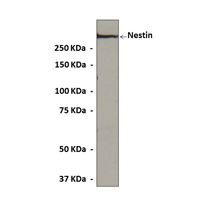Anti-Nestin: Rabbit Nestin Antibody |
 |
BACKGROUND Nestin is a class VI intermediate filament protein that was originally described as a neuronal stem cell/progenitor marker during central nervous system (CNS) development, and is currently widely used in that capacity. IFs are classified into six subtypes, and the IF protein members are expressed in specific cell types, for example, keratin in epithelial cells, vimentin in mesenchymal cells, desmin in muscular cells, neurofilament in neuronal cells, and glial fibrillar acidic protein in glial cells. Nestin contains a short N terminus and an unusually long C terminus, which interacts with other IFs including vimentin, desmin, or internexin, forming heterodimers and mixed polymers, but in contrast to other IFs, Nestin cannot form homopolymers. Nestin is known to contribute to the disassembly of vimentin during mitosis. It has been suggested that the long C-terminal portion of Nestin protrudes from the filament body and may function as a linker or cross-bridge between IFs and microtubules. The assembly and disassembly of cytoskeletal IFs modulate a variety of signaling cascades, and several lines of evidence suggest that Nestin participates in this regulation. Nestin may thus play a role in connecting the three components of the cytoskeleton and coordinate changes in cell dynamics. Nestin has a high molecular weight, which differs among organs because of modifications to the protein. Nestin is known to be phosphorylated at Thr316 by cdc2 kinase and/or cyclin-dependent kinase 5, and modulates mitosis-associated cytoplasmic reorganization during mitosis. Tissue- and cell-specific and spatiotemporal regulation of Nestin is important for cell behavior during development or in pathological conditions.1
Nestin is expressed in dividing cells during the early stages of development in the CNS, peripheral nervous system, and myogenic and other tissues. With differentiation, Nestin is downregulated and replaced by tissue-specific IF proteins, and therefore, is widely used as a neuronal stem cell marker. Nestin is also expressed in immature or progenitor cells in non-neuronal cells in normal tissues. High levels of Nestin expression have been detected in oligodendroglial lineage cells, ependymocytes, Sertoli cells, enteric glia, hair follicle cells, podocytes of renal glomeruli, pancreatic stellate cells, pericytes, islets, optic nerve, and odontoblasts. Recent work has shown that Nestin is also expressed in follicle stem cells and their immediate, differentiated progeny, and the hair follicle bulge area has been noted as an easily accessible source of actively growing pluripotent adult stem cells. In adult organisms, Nestin-expressing cells are restricted to defined locations, where they may function as a cellular reserve that is capable of proliferation, differentiation, and migration after reactivation.
In pathological conditions, Nestin is expressed in repair processes in the CNS, muscle, liver, and infarcted myocardium. Furthermore, increased Nestin expression has been reported in various tumor cells, including CNS tumors, pancreatic cancer, gastrointestinal stromal tumors (GISTs), prostate cancer, breast cancer, malignant melanoma, dermatofibrosarcoma protuberances, and thyroid tumors. Expression of Nestin in several tumors has been reported to be closely correlated with poor prognosis.2 Recently Nestin has also received attention as a cancer stem cell marker in various tumor cells including brain tumors, uterine and cervical cancers, prostate cancer, bladder cancer, head and neck cancers, ovarian cancer, testicular cancer, pancreatic cancer, and malignant rhabdoid tumors. In the tumor tissues, proliferating vascular endothelial cells also highly express Nestin, and Nestin is therefore closely correlated with tumor angiogenesis. Detailed analyses of expression patterns of Nestin in various tumor tissues and tumor angiogenesis will be helpful for examining the roles of Nestin in mechanisms of tumor growth and invasion and for finding novel therapeutic targets.3
REFERENCES
1. Gilyarov, A.V.: Neurosci. Behav. Physiol. 38:165-9, 2008
2. Ishiwata, T. et al: World J. Gastroenterol. 17:409-18, 2011
3. Krupkova, O. Jr. et al: Neoplasma 57:291-8, 2010
2. Ishiwata, T. et al: World J. Gastroenterol. 17:409-18, 2011
3. Krupkova, O. Jr. et al: Neoplasma 57:291-8, 2010
Products are for research use only. They are not intended for human, animal, or diagnostic applications.
Параметры
Cat.No.: | CY1123 |
Antigen: | Short peptide from human Nestin sequence. |
Isotype: | Rabbit IgG |
Species & predicted species cross- reactivity ( ): | Human, Mouse |
Applications & Suggested starting dilutions:* | WB 1:1000 IP n/d IHC n/d ICC n/d FACS n/d |
Predicted Molecular Weight of protein: | 250+ kDa |
Specificity/Sensitivity: | Detects endogenous Nestin proteins without cross-reactivity with other family members. |
Storage: | Store at -20°C, 4°C for frequent use. Avoid repeated freeze-thaw cycles. |
*Optimal working dilutions must be determined by end user.
Документы
Информация представлена исключительно в ознакомительных целях и ни при каких условиях не является публичной офертой








